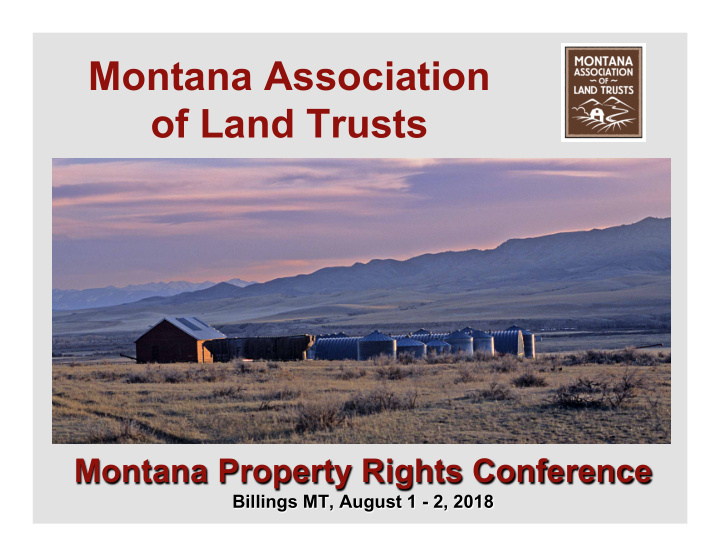



Montana Association of Land Trusts Montana Property Rights Conference Billings MT, August 1 - 2, 2018
Brief History of Montana Conservation Easements Conservation easement laws established in all 50 states. Montana Open-Space and Voluntary Conservation Easement Act passed legislature in 1975. (76-6-101) Law is unique to Montana. Montana law as created - limited government involvement; law was largely written by landowners; strong private property rights components. First conservation easement in Montana created in 1976 in Blackfoot Valley. Law has not been meaningfully amended since its original passage.
Montana Association of Land Trusts Membership • Prickly Pear Land Trust • Gallatin Valley Land Trust • The Trust for Public Land • Flathead Land Trust • Montana Land Reliance • Five Valleys Land Trust • Bitter Root Land Trust • The Conservation Fund • The Nature Conservancy • The Vital Ground Foundation • Rocky Mountain Elk Foundation • Kaniksu Land Trust
WHAT IS A Nonprofit LAND TRUST? organization Focus on private land conservation Voluntary conservation agreements Follow national standards and practices LAND TRUSTS TRUE Community based “ CUSTOMER ” IS Multiple private and LANDOWNER public partners
What is a conservation easement? It is the use of a private property right to create a voluntary, negotiated, permanent agreement between a landowner and a land trust (or public agency) that limits development and maintains open land.
What Isn’t a Conservation Easement? It isn’t eminent domain It isn’t condemnation It isn’t a wilderness It isn’t zoning It isn’t county planning It isn’t regulatory It isn’t mandated public access It isn’t prevented public access It isn’t a property tax cut It isn’t just for the wealthy It isn’t a loss of a property right It isn’t for all landowners It isn’t for all land
What does a conservation easement do? • Keeps open land as open land … limits development • Keeps agricultural and forest working lands working and producing crops, grass and trees • Conserves wildlife habitat • Conserves wildlife corridors • Conserves riparian areas and shorelines • Conserves wetlands • Conserves recreational, educational and historic properties
2018 Conservation Easement Summary Note: easement acres are calculated by the GIS and do not necessarily represent the acreage filed in the deed Easement Holder Acres US Government 3,032 US Bureau of Reclamation 42 BPA 644 US Fish and Wildlife Service 380,372 US Forest Service 19,996 US Department of Agriculture 30,088 Montana Fish, Wildlife and Parks 482,241 MT Dept. of Transportation 1,067 County Government 522 City Government 629 Salish and Kootenai Tribal Lands 282 The Nature Conservancy 395,961 Montana Land Reliance 1,030,915 Rocky Mountain Elk Foundation 52,212 DU (Wetlands America Trust) 16,998 Five Valleys Land Trust 66,299 Flathead Land Trust 10,566 Gallatin Valley Land Trust 46,781 Prickly Pear Land Trust 4,337 Bitter Root Land Trust 6,070 The Vital Ground Foundation 1638 The Bighorn Institute 1,443 National Wildlife Federation 20 Rattlesnake Land Trust (SOS) 190 Kaniksu Land Trust 762 Montana Conservation Trust 735 Humane Society Wildlife Land Trust 445 The Conservation Fund 8,585 Mule Deer Foundation 155 Institute of the Rockies 74 State Total 2,562,267
Montana is Ranked #1 or #2 in the US for Land Conservation National Conservation Easement Database Ranks Montana #1 The Land Trust Alliance Ranks Montana #2 Montana Ranked #1 in the West Montana More CE Acres Than All States Way to go, Montana! Contiguous To Us Combined
Why do landowners Cash payment: Since the easement “ retires ” seek conservation all or a portion of the development potential easements? of the land, the landowner may be compensated with a cash payment. Tax advantages: Federal income tax deductions can be attractive. Reduction in federal estate tax exposure can be attractive. Easier to pass ranch to heirs. Altruistic reasons: Family ranch, family tradition, strong bond between family and the land.
Conservation Easements & Sage Grouse • 2013 Montana Legislature • 2013 Executive Order • Montana Advisory Council • 2014 Executive Order • 2015 Montana Legislature • 2015 Executive Order • Montana Sage Grouse Oversight Team • 2017 Montana Legislature • Ongoing and Ongoing and...
Conservation Easements and Sage Grouse Stewardship Fund has Significant Opportunities and Advantages Voluntary Flexible (Term Easements) Landowner Incentives Montana is unique: A majority of sage Protect Property Rights grouse core habitat and Pro-Agriculture sage grouse Keep Private Land Private Land populations are found Established on Landscape on private land... Montana is the only Recognized / Proven Effective state where that’s the Generate Mitigation Credits case.
10 Montana Sage Grouse Program Goals 1. Maintain sage grouse and economic opportunity. 2. Retain management authority of sage grouse. 3. Consistent application of provisions across all lands. Lots of work ahead: 4. Three-part program... DDCT, Montana continues to habitat conservation, maintain these goals mitigation. and work within these 5. Respect valid and existing program priorities. It rights and uses. has not been easy, and 6. A focus on voluntary, it will not get easier. incentive based conservation. Much work remains.
10 Montana Sage Grouse Program Goals 7. Reduce threats to sage grouse habitat and populations. 8. The program needs landowners more than landowners need the program. 9. Conservation of sage grouse Challenges Remain: and economic development, It is unclear how including energy development, emerging national are compatible. policies and actions will 10. Mitigation enables this play out in Montana, development and conservation to how the final mitigation rule will be received, and be compatible. whether landowners will participate in the program.
Recommend
More recommend